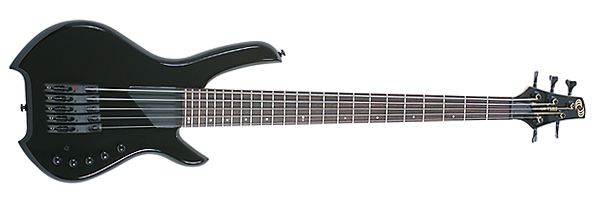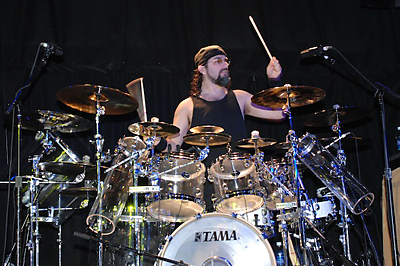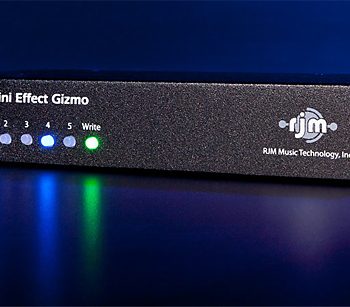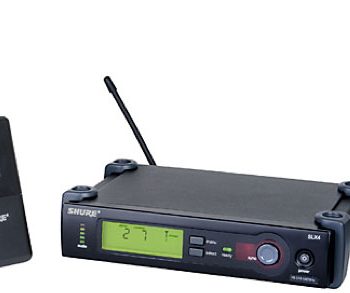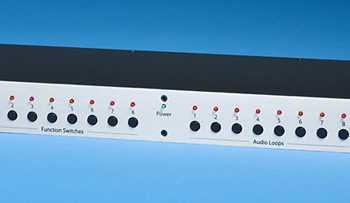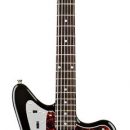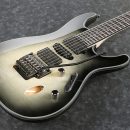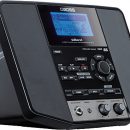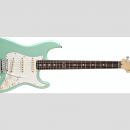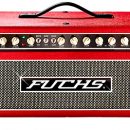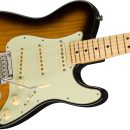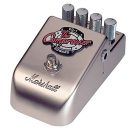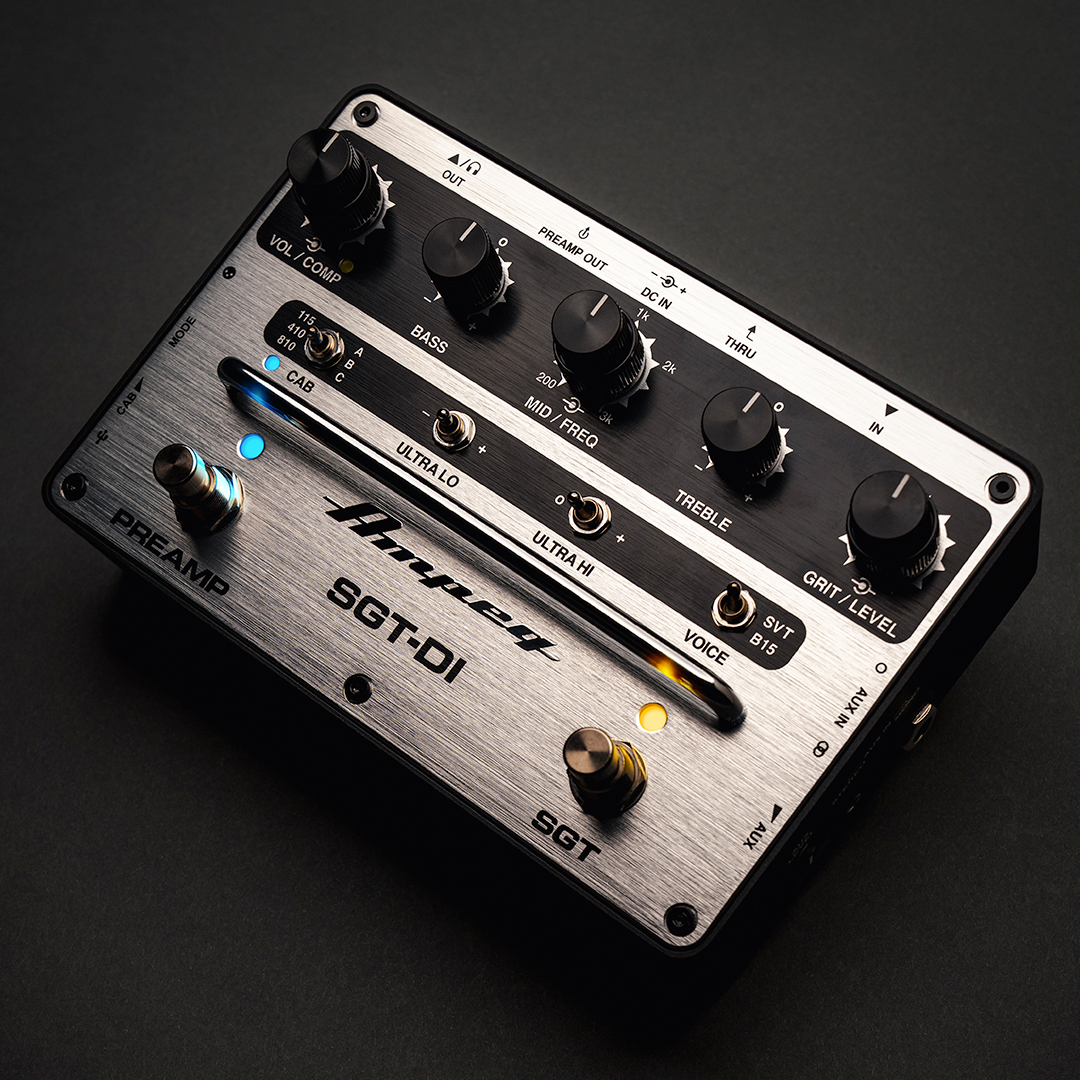
Saber VL Fretless
The Lightwave Saber Bass is a welcome sight (and sound) for bassists looking for something new. Electric guitar & bass technology has remained essentially the same since the very beginning. There certainly have been subtle improvements in magnetic pickup technology and active electronics, not to mention cleaner effects pedals and amps, but the instruments themselves have stayed pretty much the same… until now.
Unlike conventional magnetic pickups, the LightWave Saber’s optical pickups do not create a magnetic field, therefore the strings’ sustain is not affected by the slight pull of the magnet. This allows the tone of the Saber bass to sustain much longer while remaining clean, and it delivers a more natural bass tone than you’ll hear from a typical magnetic pickup.
| Category | Value | Rating | ||||
| Features | 20% |
|
||||
| Usability | 25% |
|
||||
| Sound | 25% |
|
||||
| Documentation & Support |
10% |
|
||||
| Price | 20% |
|
||||
| OVERALL RATINGS: Saber SL = 3.5 Saber VL = 3.9, which earns it a WIHO Award! 3.6 stars or better: Outstanding, WIHO Award 3 stars or better: Worth considering 2 stars or better: Suited to specific needs 1 star or less: Not recommended |
||||||
After spending two months playing with both a five-string fretted Saber SL and a four-string freless Saber VL, not only are we completely in love with their tone, but the fretless VL in particular truly captures the tone of an acoustic upright bass – incredible!
Built-in tone controls allow the player to easily design their own tone color as with traditional basses. With the optical pickups, though, you will notice something else very cool – when you lower the gain on the guitar, the quality of the tone is not diminished, nor is the sustain! Also, when you apply high levels of tone control or set the optics for a stronger bridge or fingerboard tone, you don’t get any humming from pickups being out of phase – excellent for those of you doing a lot of studio work. The overall sound of the Saber is neat and clean, balanced and very natural. This should make processing any effect sound better, too.
The Saber SL and VL models sport a fresh design – not too traditional but not too “out there” either. Everyone we showed the Saber basses to appreciated the good looks of these guitars. The biggest difference between the Saber instruments and our other basses is, of course, the tone. You will notice right away that the tone settings on your amp and/or EQ may have to be reset almost to flat levels when you first start playing with this bass. The Saber’s optical pickups produce such a clean signal that most of the EQ settings which were present (on our amp) to compensate for lack of tone are no longer required.
The Saber is also equipped with piezo pickups in the Monolith Bridge rails that add a very cool character to the instrument’s tone when blended into the signal.

Saber VL Fretless
If you are looking for a fairly versatile bass with a really clean sound that looks pretty good, at a price that won’t break the bank, The LightWave Saber SL is definitely an instrument you should test drive and consider. And if you’re looking for a fretless bass, the Saber VL should knock your short list down in size significantly – its tone is really nothing short of amazing (and helped it to win our distinguished WIHO Award). We know that everyone has different tastes, and we own a variety of pro-level basses ourselves, but no other bass guitars we’ve played dropped right into the pocket almost instantly and have been so much fun to play right out of the box.
Features
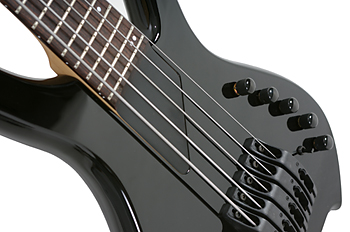 The LightWave Saber SL we tested was a five-string fretted model: solid alder body, 34” scale length, three-piece laminate hard maple neck (14” radius) with a rosewood fingerboard, nickel silver jumbo frets. Four-string and fretless versions are also available.
The LightWave Saber SL we tested was a five-string fretted model: solid alder body, 34” scale length, three-piece laminate hard maple neck (14” radius) with a rosewood fingerboard, nickel silver jumbo frets. Four-string and fretless versions are also available.
The Saber VL we tested was a four-string fretless model that only differs from the SL in that it has a chambered swamp ash body and a fretboard made from treated basswood, making it extremely smooth to the touch and rock solid for good contact with the string. With its small sound hole cutout on the body, the look of the Saber VL is nothing short of gorgeous, especially with the hot red flamed maple top on our test instrument.
The single most unique feature of these basses (of course) are the optical pickups. Unlike a conventional magnetic pickup that generates a magnetic field to interact with your strings, and thus alter your strings’ natural vibration, optical pickups use infrared light to observer your strings’ natural vibration and translate that vibration into sound while remaining transparent to the signal path. While various magnetic pickups are optimized to change the tone of an instrument in some particular way, the optical pickup’s job is to capture the sound without changing it at all.
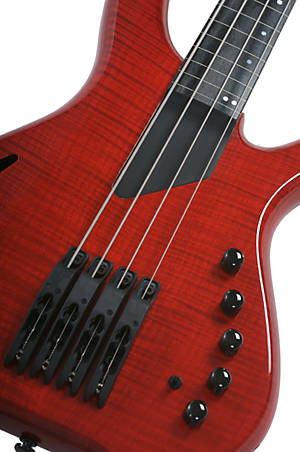 The basic Saber SL and VL controls for volume, blend and tone are standard and therefore very easy to use. There is also a special Mids center frequency sweep control knob. This allows you to create a greater range of tone by widening or narrowing the frequency between 220Hz and 1kHz. At lower settings, the sweep has a narrower “Q” setting for altering a narrower band of frequencies, and the “Q” is wider at higher settings for boosting presence.
The basic Saber SL and VL controls for volume, blend and tone are standard and therefore very easy to use. There is also a special Mids center frequency sweep control knob. This allows you to create a greater range of tone by widening or narrowing the frequency between 220Hz and 1kHz. At lower settings, the sweep has a narrower “Q” setting for altering a narrower band of frequencies, and the “Q” is wider at higher settings for boosting presence.
A two-way toggle switch (called the Warm/Cool switch) does just that, almost simulating the experience of selecting between a magnetic bridge or neck pickup in the magnetic world. In the Warm position, the EQ of the bass tone is a smooth, solid, deep bass. The Cool setting shifts the overall EQ curve of the bass to sound brighter.
Built into the very slick-looking Monolith Bridge saddles are piezo transducers which, when activated via the iceTone control knob, blends the piezo tone with the optical pickups to add another dimension to your sound. The piezo pickups do not function in the manner you’re more accustomed to – i.e. they do not specifically generate the tone of an acoustic bass. They are purely part of the instrument for shaping its overall sonic palette.
The custom-designed Monolith Bridge rails are not only very neat looking but they offer virtually all adjustable parameters you need for setting intonation, action and aligning the optics (more on this later).
Basses with active electronics have forced us to have a ready supply of nine-volt batteries on hand at all times, so the built in rechargeable NiMH battery is a really nice feature to have. The built-in battery provides a long power life and is simple to maintain. An LED indicator on the bridge lets you know when the battery is running low on power. When the LED is lit, you’re good to go, and a full one-hour charge provides approximately sixteen hours of playing time. When the light goes out, you still have power for about an hour or two. The battery charger (provided) can be plugged in for a quick charge before a show, but if you can’t wait, the charger will charge the battery while you are playing.
Usability
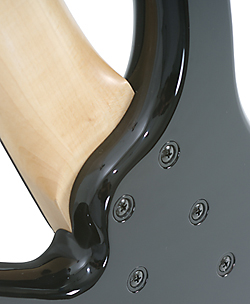 Right out of the box the Saber SL was ready to go. We didn’t even need to charge it until after a few days of playing.
Right out of the box the Saber SL was ready to go. We didn’t even need to charge it until after a few days of playing.
The feel of the instrument was very easy to adapt to. The shape is unique, but not so “out there” that you have to alter your playing style. We found it almost seamless to begin playing just about any style. The only thing we noticed was that it seemed to be top heavy at first, but playing around with our strap length solved most of that problem. We also missed having a thumb rest. However, the two-octave fingerboard provided an alternate resting place, and we became used to the different position sooner than we might have expected.
The overall feel of the Saber SL bass was what you would expect from a quality-built instrument. The two-octave fingerboard worked well with the body design making it very easy to play higher notes, and the smooth finish on the neck didn’t slow us down either. The size and the shape of the neck allowed for easy movement up & down the bass on all five strings. The round wound strings supplied with the Saber SL were very playable, but depending on you tastes, you may want to try your favorite brand to see how they sound with the optical pickups on this bass. Keep in mind that you may experience very different tones from your favorite strings because the pickups are so clean (more on that in the Sound section) that they may reproduce overtones you never heard before!
If you don’t like the factory settings (action, gain etc), you can spend a little time – and we really mean just a little, making your own tweaks to the bass setup. When we first received the bass, we wanted the action to be lower. Making the string height adjustments was very simple. All adjustment points were accessed from various setscrews on the Monolith Bridge saddles. [Editor’s Note: LightWave has informed us that current shipments now have a lower action set at their factory.]
At first, we didn’t even have to open the back panel to realign the optics, but our curiosity got the better of us and we went for it. To our pleasure and surprise, having never before worked with optical pickup technology, making the optic and trim adjustments took less than forty-five minutes (the bass came with expert documentation on this, but more about that in the Documentation section).
Five screws on the back plate offered access to the motherboard. You will only need to access this panel if you adjust the string height. Since the tone relies on the optics to target the string, setting a higher or lower actions requires resetting the optic height, too. The manual details the steps to accomplish this through the back panel, but you can also reset the optics by ear. Using the precise method detailed in the instructions, an LED indicator on the logic board showed us when we adjusted the optics to their “optimal” position after we had set the action to our personal taste.
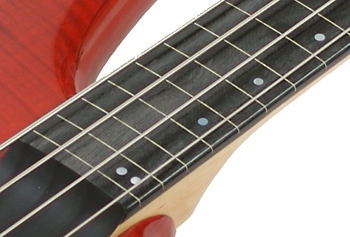 Using only our ears to adjust the optics was easy, too. Because the optic adjusters are located on the Monolith Bridge Saddle (one for each string), if you trust you ear, it is very easy to reset the optics without ever opening the back panel. All adjustments were made using standard Allen wrenches supplied with the instrument.
Using only our ears to adjust the optics was easy, too. Because the optic adjusters are located on the Monolith Bridge Saddle (one for each string), if you trust you ear, it is very easy to reset the optics without ever opening the back panel. All adjustments were made using standard Allen wrenches supplied with the instrument.
We didn’t make any adjustments to the Saber VL freless. It played like a dream. When playing and sliding our fingers across the fretboard, it was very easy to produce killer fretless tones, which is why we all buy one to begin with, but we’ll tell you more about that in the next section.
Sound
The sound of both LightWave Saber basses was so clean and clear that we had to level our EQ settings to completely flat! We were amazed at the clarity of the tone through our Peavey 400 watt digital bass amp that we used. We reset the EQ to slightly enhance the bottom end for a little more punch and that was it! The tone controls on the bass were really all we needed to create deep bass tones, popping treble tones for a funkier feel (on the SL) and everything in between.
Saber SL Fretted
The Saber SL dished up the best tones and overall sound we were shooting for in a variety of styles: straightforward jazz, hard driving rock, and smooth ballads. All of these sounds were very clean and recorded so well in our studio test that even the engineer commented on how precise the sound was. He simply added a little compression and that was it!
One other very cool sound we discovered was when you roll off the bass tone, pump up the treble tone and play around with the bridge/fingerboard balance knob, you get an almost piano string tone quality (If you have ever opened up a piano and lightly plucked one string, you’ll know what we are talking about). We were amazed when we heard this. If you are trying to find more sounds for your band or original music, try this bass out – very cool!
We did, however, notice that when we tried to get a real funky pop/slap sound, the initial punch was not as strong as we expected. Playing with EQ settings helped a little, but the articulation still fell a bit short. The slap back of the strings to frets in the funkier style also seemed too muffled. The slap sound was a little better once we adjusted the EQ settings, but again fell short of our expectations. This difference occurs presumably because of the lack of a magnet interacting with the bass strings. LightWave just started shipping the Saber Hybrid bass, which includes a magnetic pickup, to better facilitate funk-style playing, and we’ll be reviewing that instrument soon.
When we plugged into an effects box, the desired effect didn’t create the sound we were initially going for – the optical pickups responded a little bit different compared to our magnetic-equipped instruments, but that was very easy to fix when we placed our effects in the effects loop in back of the bass amp. With that simple change, our effects sounded great!
We tried using the bass in several different situations to see how roadworthy it was, and it never let us down. We took it to a couple of live gigs, tried it out in a home studio set up using a Lexicon interface through a Dell computer, and straight into Pro Tools in a full blown professional recording studio. The sound was always better than we anticipated.
Saber VL Fretless
The chambered body of the VL wasn’t just incredible to look at, but its design (and different wood) seemed to give the VL a unique yet subtle tone difference from the solid-body SL. We think that the chamber allows for more resonance of the instrument body, and when the tone knobs and balance were set to our taste, we were able to command a true upright bass sound.
When it came time to let our fingers do the sliding, every movement of our fingers on the string was clear and reproduced the exact tones we were trying to hear. The classic fretless (ala Jaco) pitch bending of the tone was virtually flawless. Every subtle movement of the finger, even vibrato, was dead on.
EQ settings in both live and studio applications were flat. No enhancements of the tone through amps or mixing boards were necessary. We didn’t even need to use any external effects to achieve the perfect fretless and upright bass sounds we were after. Of course beyond our “pure” tests, we did apply certain effects to hear their affect of the tone.
These effects only needed to be turned up slightly to be heard. The best sounding effects were a little flanger, wah (although with fretless this was almost redundant), and a hint of octave doubling. The five string VL would probably eliminate most of the need for doubling, though.
As with the Saber SL, we used the Saber VL in several real-life playing situations including the recording studio, live gigs, and home studio recording. In every situation where we used the VL, we not only got comments of “Wow! What a neat looking bass!” but we experienced real jaw-dropping looks from other bassists, sound engineers, and musicians who had an appreciation for great bass sound.
The clean tone reproduction of the optical pick-ups combined with the chambered body design and the incredibly smooth fingerboard made for a super fretless sound that instantly put a smile on our faces.
This fretless would be perfect for any bassist seeking a fretless instrument – not just jazz or blues players. The Saber VL is a super-clean sounding instrument with all of the cool new technology of the Saber line plus a fantastic fingerboard and chambered body for incredible bass tone.
Documentation and Product Support
The user manual for the bass is only fourteen pages long (unlike other manuals for microwave ovens or lawnmowers), but that’s at least ten to twelve more pages than the typical documentation that comes with a bass guitar. Happily, it offers everything you would need to know to set up and maintain the bass to your personal taste. The manual includes pictures of the motherboard and easy-to-follow instructions for the adjusting of the controls inside and out.
There are close-ups of the adjusting points on the Monolith Bridge for action, intonation and optics adjusting. The manual is written as clearly as the bass sounds. We found that to make any adjustment took only moments.
The manual gives excellent information on everything from doing an initial setup to how to maintain the NiMH battery for long life.
The warranty is a typical one-year warranty on materials and workmanship. We thought that with a new technology like the optical pickups, a longer warranty should be offered on at least the electronics, but we never experienced any problem during our month of active playing.
If you’re curious, you can download a PDF file for the manual from LightWave’s website.
Price
The list price for the basic Lightwave Saber SL four-String bass is $1,295.00 and a very reasonable $100.00 more can get the SL five-string at $1,395.00. The Saber VL four-string fretless has an MSRP of $1,645.
As most quality basses go, these are very good prices when you consider the technology inside and the full features these instruments offer.
Make no mistake – although we’re all just discovering the LightWave brand, these are quality instruments with professional features and killer sound.
Other Comments
The technology inside the Saber SL bass isn’t completely new, so don’t be hesitant to check it out if you are worried that this is brand new technology. LightWave has been making the optical pickup technology for at least five years now, and previously, you were able to custom order their electronics installed on select premium instruments from manufacturers such as Zon. Unfortunately for mere mortals, the $3,500 price tag on those optical-equipped basses made them all but unobtainable for most players.
Contact Information
Lightwave Systems, Inc.
www.lightwave-systems.com
Evaluation Short-List
- LightWave instruments are the first and (currently) only production instruments to feature optical pickups. As such, there are no direct comparisons.

